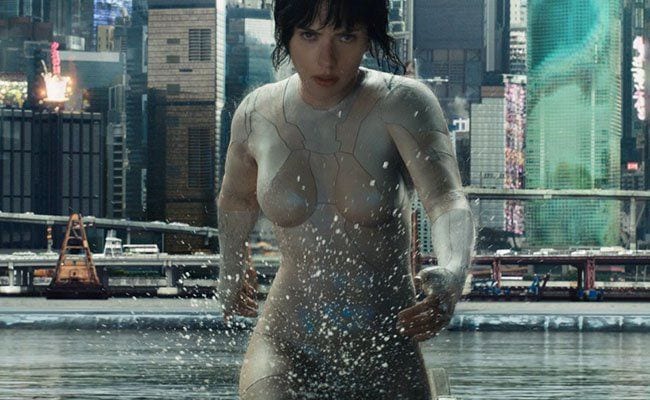The newest addition to the Ghost in the Shell franchise, co-produced by Shanghai Film Group Corporation, Arad Productions, DreamWorks Pictures, Reliance Entertainment, and Huahua Media, is a beautifully designed fast-paced action thriller that creates a richly detailed dystopian future world, replicating and expanding on the aesthetics of the rest of the franchise. This version drops the gore, the dismembered naked female android torsos, and the static shots of characters pontificating philosophically to the viewer, opting for a visually sumptuous, thrilling, sci-fi action movie about the central character’s quest for her identity.
Oshii Mamoru’s original anime adaptation of Shiro Masamune’s seinen manga Kokaku Kidotai, known in English translation as Ghost in the Shell, is a masterwork of Japanese animation, violently and explicitly exploring the meaning of being human in a technically sophisticated, beautifully drawn and designed cyberpunk action thriller. Ghost in the Shell has since been recognized as a classic anime, birthing a franchise of series and movies, generating an avid fanbase, as well as influencing later filmmakers working in sci-fi media. The newest version of the story, directed by Rupert Sanders and starring Scarlett Johansson, takes the basic shell of Oshii’s movie and riffs on characters, storylines and themes plugged in from all of the various iterations of the Ghost in the Shell world.
Scarlett Johansson has developed her career playing driven, martial, otherworldly women. In Luc Besson’s Lucy (2014) she is a drug mule who is transformed into a superhuman with psychokinetic powers after being forced to ingest a massive amount of an experimental drug. In Jonathan Glazer’s Under the Skin (2013), she gave a haunting performance as an alien hunting human who suffers a personal crisis when she begins to identify with her prey. In each of these roles Johansson makes these eerie situations relatable, and in Ghost in the Shell, she does so again with skill, expressing the experience of being a wired living brain in a synthetic body that she cannot feel, a body enhanced with strength, skill and speed.
As Major Mira Killian, Johansson plays a woman transformed and questioning her identity as she experiences “glitches” which makes her see objects or animals that are not there. Her creator Dr. Ouelet (Juliette Binoche) tells her that these are echoes from her “ghost”, the original refugee woman who was almost killed in a terrorist attack, and whose wrecked body they harvested her brain from.
Major, as members of her team call her, feels an affinity for the robots that she takes down, such as in the aftermath of the first major action sequence, involving Weta Workshop’s brilliantly designed insectoid-like murderous geisha-bots (modeled on Rila Fukushima), when she pauses to consider one of the geisha robot’s cry for help. At the same time, she is registered as human by those around her, even though she is a product of the military industrial complex, whose body must be constantly maintained in a sophisticated lab. She has to take drugs that suppress her ghost’s memories so that she functions properly as a weapon for the special police force called Section 9 that targets cyberterrorists.
While Major struggles with the mystery of her memories, she and Batou (Pilou Asbaek), her lens-eyed partner, search for a hacker called the Puppet Master (Michael Pitt) who steals and hacks enhanced people’s memories. In the 1995 anime, one of the overarching themes was the question of who and what counts as human. The evolution of human-machine consciousness is hinted at in this version, but here, Major’s quest to fully understand the glitch-images and remember her original ghost is her main concern, and the mystery that she, Batou and the rest of Section 9 must solve is intertwined with her crisis.
The cityscape of the fictional futuristic international Port City, is beautifully rendered by Atomic Fiction and MPC Montreal, with technicolor lights blinking off of stained surfaces and massive, pixelated holograms hovering over dusty streets, alleys and shops that look lived-in and used. Major falls through the hazy air of this landscape, busting through windows in the pale custom-designed bodysuit that hugs her form, displaying the kinetic beauty of Scarlett Johansson’s digitally enhanced body as she jumps, runs and kicks her way through adversaries. Overall the filmmakers nicely reproduced the look of each of the characters’ animated version, including visual cues from other iterations of the franchise.
Takeshi “Beat” Kitano uses his brief screen time to the fullest as Chief Aramaki and gets to really let loose in one great scene. Togusa (Chin Han — read interview here), Ladriya (Danusia Samal) and Ishikawa (Lasarus Ratuere) are established early on as a part of Major’s team, but don’t get enough screen time to develop their characters. This is because ultimately the narrative focuses on Major’s search for and interactions with Kuze the Puppet Master and her attempts to convince herself that her suppressed memories don’t matter.
But her memories do matter and after spending enough time with Kuze, much like in Johansson’s other sci-fi roles, Major realizes she must come to violent terms with her transformation and her double identity. When the corporation that designed your synthetic body decides that they don’t want you to know yourself, that means you’ll have to fight a spider tank — with your bare hands.

